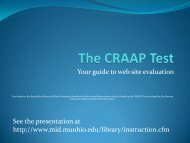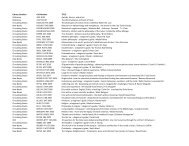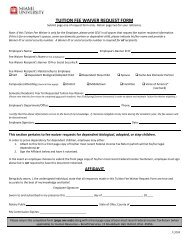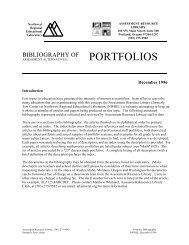Defining, Documenting, and Evaluating Service A ... - Miami University
Defining, Documenting, and Evaluating Service A ... - Miami University
Defining, Documenting, and Evaluating Service A ... - Miami University
You also want an ePaper? Increase the reach of your titles
YUMPU automatically turns print PDFs into web optimized ePapers that Google loves.
I. Introduction<br />
In April 2008 the <strong>University</strong> Senate approved a policy designated “Evaluation of <strong>Service</strong> for<br />
Regional Campus Faculty.” It began this way:<br />
“<strong>Service</strong> plays an important role in the professional lives of all faculty at <strong>Miami</strong>. For<br />
colleagues at Hamilton <strong>and</strong> Middletown, service is especially critical because it can be used as<br />
their second criterion for tenure <strong>and</strong> promotion. More generally, the regional campuses have<br />
an important role to play in their communities that is distinct from Oxford.”<br />
The policy characterized service of four different types (institutional, professional,<br />
community engagement, <strong>and</strong> community outreach). It required faculty who came under its<br />
purview to develop service plans <strong>and</strong> service portfolios in an “intentional <strong>and</strong> strategic”<br />
manner. It also specified that that faculty service in general should “rise to a commensurate<br />
level of intellectual rigor <strong>and</strong> quality as is expected of teaching <strong>and</strong> scholarship,” <strong>and</strong> that<br />
service be evaluated in an systematic manner using “criteria such as the depth of expertise <strong>and</strong><br />
preparation, quality of the work, impact, <strong>and</strong> appropriateness of goals.”<br />
This document elaborates on the directives of that policy <strong>and</strong> attempts to establish a more<br />
detailed common underst<strong>and</strong>ing <strong>and</strong> vocabulary by which faculty service can be described<br />
<strong>and</strong> evaluated.<br />
The criteria for defining, documenting, <strong>and</strong> evaluating the quality of service (parts II, III, VI,<br />
<strong>and</strong> VII of this document) broadly apply to all regional campus faculty for whom service<br />
constitutes an established part of their professional duties. Annual activities reports should<br />
show that service has been significant in terms of the faculty member’s contributions <strong>and</strong> the<br />
service activities’ impact, based on the definitions in this document.<br />
The criteria for service agendas <strong>and</strong> service portfolios (parts IV <strong>and</strong> V of this document) apply<br />
to all regional campus faculty whose tenure-eligible appointment began on or after July 1,<br />
2008, <strong>and</strong> who chose service as their second criterion for tenure <strong>and</strong> promotion. Other faculty<br />
members may elect to be considered under current policy or under the previous policy as it<br />
was set forth in MUPIM, section 7 <strong>and</strong> departmental promotion & tenure guidelines.<br />
II. Definition of <strong>Service</strong><br />
<strong>Service</strong> applies a faculty member’s knowledge, skills, <strong>and</strong> expertise as an educator, a member<br />
of a discipline or profession, or a participant in an institution to benefit students, the<br />
institution, the discipline or profession, <strong>and</strong> the community in a manner consistent with the<br />
missions of the university <strong>and</strong> the campus.<br />
To be evaluated as effective in service, the faculty member needs to document what was<br />
accomplished, what role he or she played in it, <strong>and</strong> its significance or impact.<br />
1










